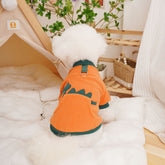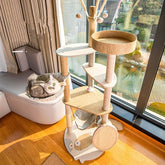The Calming Effect of Scruffing: Understanding the Science Behind Holding Cats by the Neck
Table of Contents
- Key Highlights:
- Introduction
- The Science of Scruffing
- The Right Way to Hold a Cat by the Scruff
- Common Misconceptions About Scruffing
- Recognizing Signs of Discomfort
- Q&A with Veterinary Experts
- When to Seek Veterinary Advice
- Conclusion: The Path to a Healthy Relationship with Your Cat
Key Highlights:
- Holding a cat by the scruff triggers a calming instinct linked to their kittenhood, making some cats relax and go limp.
- While this technique can be effective for certain cats, not all respond positively, and it should be used sparingly and with caution.
- Misconceptions abound regarding scruffing, particularly its role as a disciplinary measure, which can severely impact the human-animal bond.
Introduction
Cats are enigmatic companions, exhibiting a range of behaviors that can confound even the most seasoned pet owners. Among these behaviors is the practice of holding a cat by the scruff of its neck, a technique often seen in mother cats transporting their kittens or used by veterinarians to calm anxious felines. This article delves into the science behind why scruffing can have a calming effect, the proper way to implement this technique, and the critical considerations every cat owner should keep in mind. Understanding this instinctual behavior is essential not only for the well-being of the cat but also for fostering a strong bond between pet and owner.
The Science of Scruffing
The scruff refers to the loose skin on the back of a cat's neck, which has a unique physiological and behavioral significance. When a cat is grasped by the scruff, it often elicits an instinctual response that can trace its roots back to their early days as kittens. Mother cats routinely use this method to carry their young, who are not yet capable of supporting their own weight. This instinctual behavior helps the kittens feel secure and cared for during their vulnerable stages of development.
Instinctual Roots
Kittens, when held by their mother, experience a unique combination of security and passive submission. This behavior is not merely a means of transportation; it is a form of nurturing that reinforces the bond between mother and offspring. The scruff-holding technique elicits a similar response in adult cats, who may relax and display submissive behaviors when held this way, mimicking the comfort and safety they felt as kittens.
Behavioral Responses
When a cat is held by the scruff, several observable behaviors may occur:
- Relaxation: The cat may go limp, indicating a state of calm.
- Calmness: Vocalizations may cease, and struggling may stop.
- Submissiveness: Cats may lower their heads or ears, signaling trust in the handler.
These responses are not universal; some cats may find scruffing distressing or uncomfortable. Hence, it's vital to understand each cat's individual temperament and comfort levels.
The Right Way to Hold a Cat by the Scruff
While scruffing can be beneficial in specific contexts, it requires a nuanced approach to ensure that the experience is positive for the cat. Here are essential guidelines for safely and effectively using the scruff-holding technique:
Approach with Care
Approaching your cat gently is paramount. Start by familiarizing your cat with your presence and ensuring they are comfortable in your vicinity. Sudden movements or a lack of respect for their personal space can incite fear or aggression.
Technique Matters
When holding a cat by the scruff, use only a gentle grip:
- Locate the Scruff: Identify the loose skin at the back of the neck.
- Grip Firmly but Gently: Use your thumb and forefinger to grasp the scruff, lifting the cat slightly off the ground. Avoid lifting them too high or for extended periods.
- Observe Reactions: Pay attention to your cat’s body language. Signs of distress include vocalizations, attempts to escape, or tense body posture.
Timing and Context
Use scruffing judiciously. It can be effective in situations such as:
- Transporting an anxious cat to a crate.
- Calming a cat during a veterinary visit.
- Managing a cat that is overly excited or agitated.
However, it should never be a primary method of handling or disciplining a cat. Positive reinforcement and gentle handling are far more effective for training and maintaining a healthy relationship.
Common Misconceptions About Scruffing
Despite its potential benefits, several misconceptions exist surrounding the technique of scruffing. Understanding these myths can help cat owners make informed decisions about handling their pets.
Myth 1: Scruffing is Always Calming
While some cats may respond positively to being held by the scruff, others may react negatively. Factors affecting this response include the cat's previous experiences, personality, and level of socialization. Owners should never assume that scruffing will be a calming experience for all cats.
Myth 2: Scruffing is an Acceptable Form of Discipline
Many pet owners mistakenly believe that scruffing can be used as a means of discipline. This approach can lead to increased stress and fear in cats, potentially damaging the relationship between the cat and its owner. Instead, positive reinforcement techniques should be prioritized for correcting unwanted behaviors.
Myth 3: All Cats Are the Same
Just as humans have individual preferences, so do cats. Some may enjoy being held, while others may find it distressing. It is crucial to observe each cat's unique personality and adapt handling techniques accordingly.
Recognizing Signs of Discomfort
Understanding a cat's body language is essential to ensuring their comfort while handling them. Signs that a cat is uncomfortable with being held by the scruff include:
- Vocalizations: Hissing, growling, or yowling are clear indicators of distress.
- Tense Body Language: A stiff body or an arched back can signify discomfort.
- Attempts to Escape: If a cat struggles or tries to jump away, it’s a strong sign that they are not comfortable.
Q&A with Veterinary Experts
Q: Is it safe to hold my cat by the scruff?
A: While some cats may find it calming, not all cats respond positively to being held by the scruff. It’s essential to pay attention to your cat’s comfort level and body language.
Q: Why do mother cats carry their kittens by the scruff?
A: Mother cats carry their kittens by the scruff to transport them safely and without causing harm. Kittens are unable to support their own weight and rely on their mothers for care and protection.
Q: Can holding a cat by the scruff cause pain or injury?
A: When done correctly and gently, holding a cat by the scruff should not cause pain or injury. However, it’s essential to be mindful of your cat’s comfort and only use this technique when necessary.
Q: How can I tell if my cat is comfortable with being held by the scruff?
A: Watch for signs of relaxation, such as a limp body and reduced tension. If your cat shows signs of distress or discomfort, it’s best to avoid using this handling technique.
Q: Should I use the scruff-holding technique to discipline my cat?
A: No, it’s not recommended to use holding by the scruff as a form of discipline. Cats respond best to positive reinforcement and gentle, consistent training methods.
When to Seek Veterinary Advice
There are times when consulting a veterinarian or animal behaviorist is crucial:
- If your cat shows signs of distress or discomfort when being held by the scruff.
- If your cat exhibits aggressive behavior when picked up by the scruff.
- If you are uncertain about the best handling techniques for your cat, professional guidance can be invaluable.
Conclusion: The Path to a Healthy Relationship with Your Cat
Understanding the scruff-holding technique's nuances is essential for cat owners. While it can offer calming benefits in specific scenarios, it is not a one-size-fits-all solution. Each cat is unique, and fostering a respectful and trusting relationship requires attention to their individual responses and comfort levels. By prioritizing gentle handling, positive reinforcement, and consulting with professionals when necessary, cat owners can create a nurturing environment that promotes the well-being of their feline companions.





